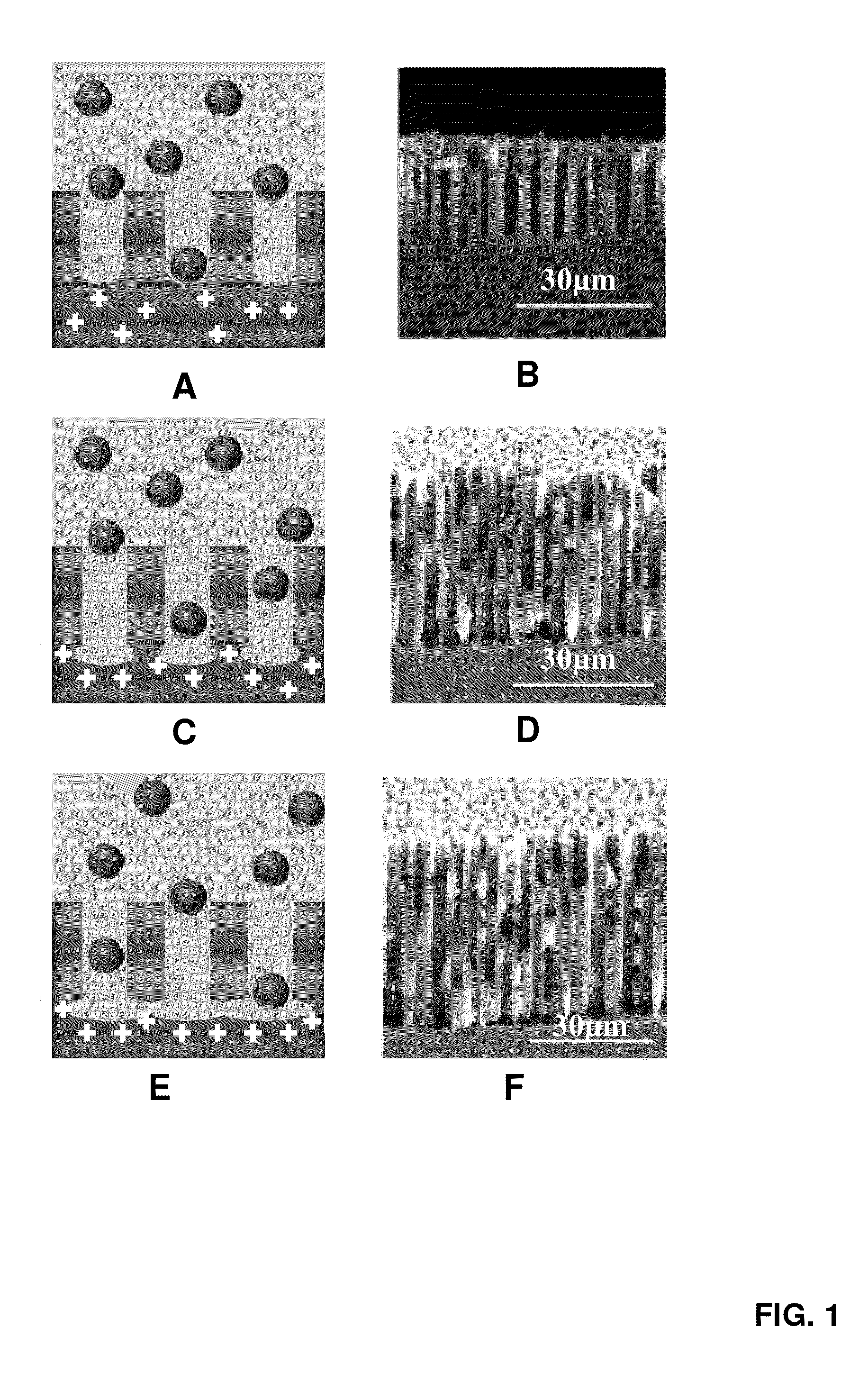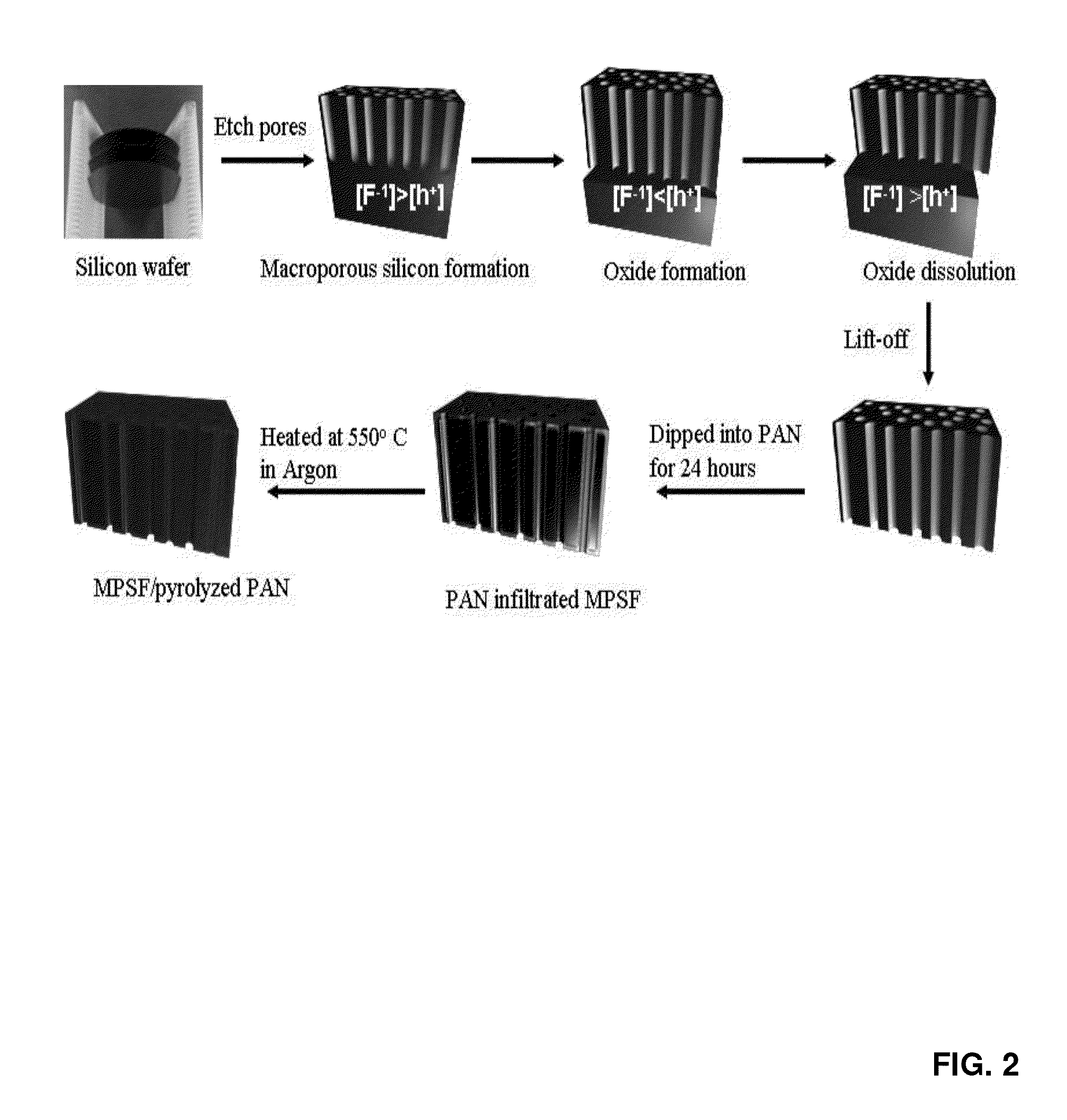Anode battery materials and methods of making the same
a technology of anode batteries and materials, applied in the direction of cell components, conductors, electrochemical generators, etc., can solve the problems of increasing the cost of production, so as to improve the cycle life, reduce the waste of silicon materials, and improve the effect of discharge capacity
- Summary
- Abstract
- Description
- Claims
- Application Information
AI Technical Summary
Benefits of technology
Problems solved by technology
Method used
Image
Examples
example 1
Development of Freestanding Macroporous Silicon Films
[0080]Here, Applicants present a novel “lift-off” method by which a freestanding macroporous silicon film (MPSF) is electrochemically detached from the underlying bulk silicon and combined with pyrolyzed polyacrylonitrile (PPAN), a conductive polymer that forms a conjugated-chain chemical structure. Applicants also report here the performance of these silicon thin films with and without pyrolyzed PAN.
[0081]Specifically, Applicants report in this Example a facile method to fabricate thin films of MPSF to be used as an anode material for lithium ion batteries (LIB). Unlike structured porous silicon or silicon nanowire arrays that have been previously reported, Applicants' thin films are electrochemically removed from the bulk silicon substrate. This freestanding MPSF is fabricated by electrochemical etching of silicon wafer in hydrofluoric acid (HF) solution using a multi-step lift-off procedure. To these porous silicon thin films, ...
example 1.1
Materials and Methods
[0082]Freestanding macroporous silicon film (MPSF) can be fabricated by etching crystalline silicon wafers with hydrofluoric acid and organic solvents at a constant electric current density. The porosity and depth of the porous silicon can be controlled by varying the current density or concentration of HF acid. Prior work has shown that the free-standing MPSF can be removed from the bulk silicon using either a one step process or a two step process. In the one step anodization liftoff procedure, the in-situ change in fluoride ion concentration results in the formation of a high porosity layer beneath a low porosity layer under the same etching conditions. The pores in the high porosity layer then eventually expand to overlap one another until the porous silicon breaks away from the substrate. In the two step procedure, a silicon wafer is first etched at a constant current density to create isotropic pores. Then, the current density is suddenly increased causing...
example 1.2
Results and Discussion
[0090]The cycling performance of bare freestanding MPSF and MPSF with pyrolyzed PAN is shown in FIG. 4. For the MPSF with pyrolyzed PAN, the total mass of the anode is 4 mg measured using a microbalance (A&D—HR-202i, resolution 0.1 μg). The ratio of C to Si is 1:1. The first cycle discharge capacity for the MPSF / pyrolyzedPAN is 850 mAh / g−1, whereas the bare MPSF is 757 mAh / g−1. The bare MPSF rapidly drops in capacity after the second cycle, and is 200 mAh / g−1 by cycle 10, and completely fails by cycle 15. For MPSF with pyrolyzed PAN, the discharge capacity increases for the first four cycles to a discharge capacity of 1260 mAhg−1, and remains constant through cycle 20. This initial increase in capacity is typical for porous silicon films.
[0091]When analyzing galvanostatic cycling data, it is important to note the difference between the charge (lithiation) and discharge (delithiation) capacities, as this is an indication of reversibility (coulombic efficiency). ...
PUM
| Property | Measurement | Unit |
|---|---|---|
| diameters | aaaaa | aaaaa |
| diameters | aaaaa | aaaaa |
| thickness | aaaaa | aaaaa |
Abstract
Description
Claims
Application Information
 Login to View More
Login to View More - R&D
- Intellectual Property
- Life Sciences
- Materials
- Tech Scout
- Unparalleled Data Quality
- Higher Quality Content
- 60% Fewer Hallucinations
Browse by: Latest US Patents, China's latest patents, Technical Efficacy Thesaurus, Application Domain, Technology Topic, Popular Technical Reports.
© 2025 PatSnap. All rights reserved.Legal|Privacy policy|Modern Slavery Act Transparency Statement|Sitemap|About US| Contact US: help@patsnap.com



